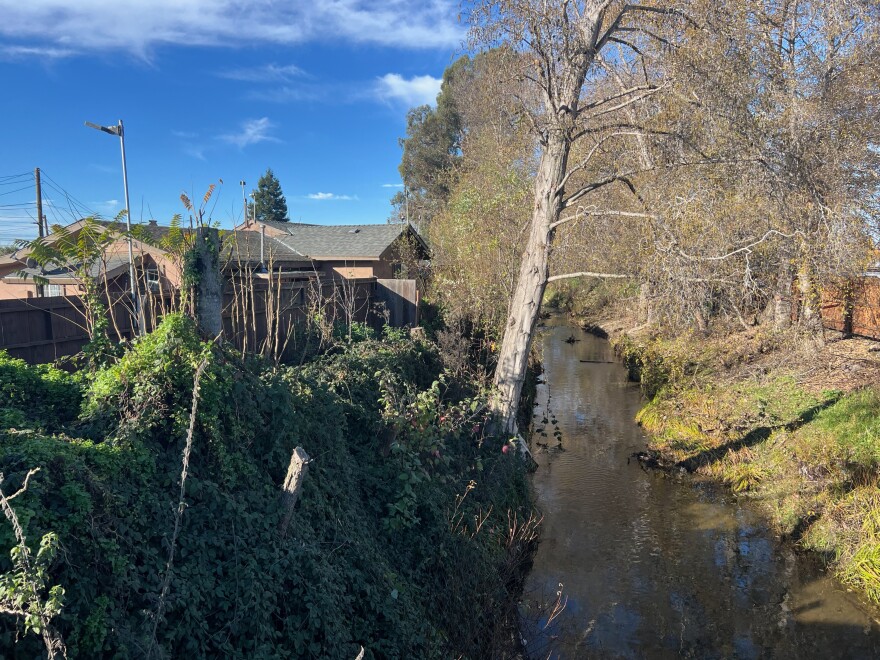Mark Strudley, Executive Director of the Pajaro Regional Flood Management Agency, said that his agency, as well as Monterey and Santa Cruz Counties, have done considerable work on the system since last year’s flood that left some 3,000 people homeless in the town of Pajaro. The work includes new pumps, and more than $240,000 in vegetation removal.
But he said the real fix will be the $600 million reconstruction of the system, which received final approval last year.
KAZU spoke with Strudley near the spot where construction will begin — in Watsonville, along Corralitos Creek, which feeds into the Pajaro River.
This interview has been edited for clarity.
KAZU: What are we about to see?

Mark Strudley, Executive Director, Pajaro Regional Flood Management Agency: So, sometime later this summer or maybe early fall, there's going to be construction activities that happen out there on Corralitos Creek in that area to get ready to build some new levees out there.
KAZU: As part of that, there's going to be some displacement of residents, and just some general disruptions. So, what are you seeing there and what are you doing to try and ease that transition for the people?
Strudley: It's unfortunate that some of the pattern of planning in this area has put a few structures just too close to these creeks to not have to move those structures in order to build this new levee system. And so, we are taking the utmost sensitivity and care in addressing those few parcels where those structures are going to need to be demolished to make way for the new levee system. We have partnerships with consultants as well as community organizations out here, like The Community Action Board of Santa Cruz County, to assist us in getting all the relocation benefits that are deserved to those residents that would unfortunately need to be moved out of those parcels.
KAZU: As we get into, now, the thick of the rainy season, the thick of winter, how does the levee compare to the levee that failed last year? Is it essentially the same levee or is it at least incrementally better?
Strudley: It's incrementally better, in that the three repairs that were made by the Army Corps (of Engineers) are today's engineering standards. And so, they're actually stronger than the older parts of the levee immediately adjacent to those repairs. The other thing is that both counties, as well as our agency, have been spending hundreds of thousands of dollars in preparing for this winter. It's a better levee than it was going into winter last year. But overall. It's still the 1940s levee that needs to be (rebuilt). It's still vulnerable, is the bottom line.
KAZU: When do we start seeing some real protection from the new levee system?
Strudley: So, the real protection is going to start on Corralitos Creek in that first section that's built. I realistically don't think it's going to be completed and ready for next winter. It's probably going to be partially there, but not fully there. So, it's really winter of 2025 that we're going to start seeing protective benefits from this new project. The great news is that AB876–which was (California State Senator John) Laird’s and (House) Speaker (Robert) Rivas’ bill that was passed late last year–that gave us those exemptions from state permits and environmental review under CEQA (the California Environmental Quality Act). It will take what is ultimately a 10-to-12-year project, and, in total, probably shave it down into the 5-to-8-year range.

KAZU: Do you finally now see some light at the end of the tunnel?
Mark Strudley: I do, I see light at the end of the tunnel. But the flip side of the coin is that we're in a race against time. So, we're speeding up the schedules for these large projects. All the while, we're trying to put these projects in the ground ahead of any floods that would continue to cause disasters for these communities. So, it's this mad, marathon race that we're in. The silver lining is that these projects are coming. These projects that everyone's been waiting for, for decades and decades. They're, they're happening. We-- the construction is happening, the—starting this year. So, it's great news.
Citing a policy against commenting on active litigation, Strudley declined to address a barrage of lawsuits naming his agency and several others — along with the State of California and Santa Cruz Monterey Counties — on behalf of hundreds of residents and businesses. The cases, which seek unspecified damages, allege the agencies did not do enough to prevent last year’s flood.



